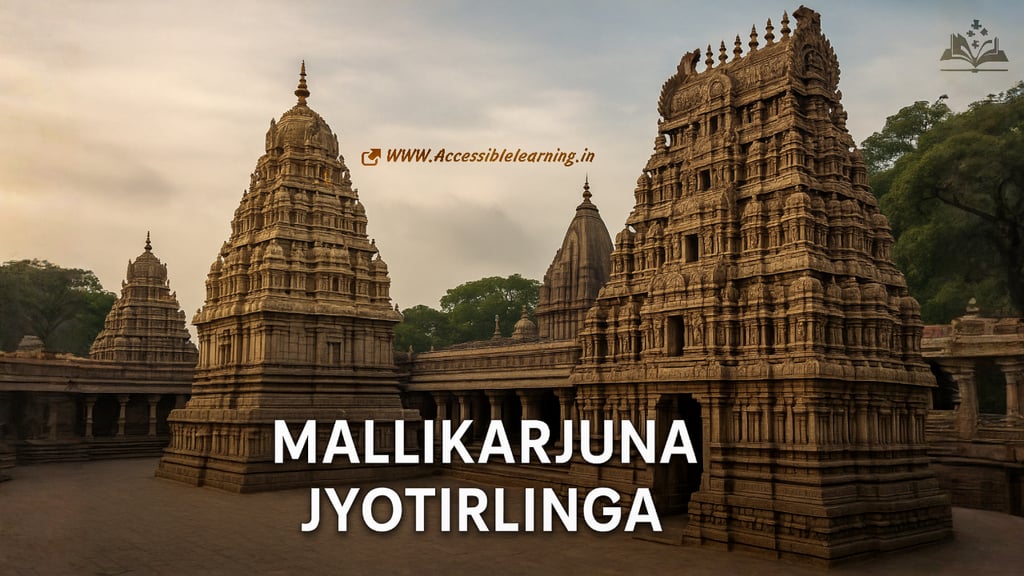
Mallikarjuna Jyotirlinga: A Sacred Abode of Devotion and History!
Mallikarjuna Jyotirlinga, also known as Srisailam Temple, is one of the twelve Jyotirlingas, which are sacred shrines dedicated to Shiv Ji. This temple is located in Srisailam, in the state of Andhra Pradesh, India. The temple holds great religious significance and is an important pilgrimage site for devotees of Shiv Ji.
TRAVEL LIFEEDUCATION/KNOWLEDGESTORY/ENTERTAINMENT
Sachin K Chaurasiya
7/18/20255 min read


Mallikarjuna Jyotirlinga, also known as Srisailam Temple, is one of the twelve Jyotirlingas, which are revered shrines dedicated to Shiv Ji. Situated in the picturesque Nallamala Hills of Andhra Pradesh, India, this temple is not only a significant religious destination but also a testament to India's rich cultural and architectural heritage. The temple's serene location and divine aura make it a center of spirituality and devotion for millions of pilgrims.
Historical & Mythological Significance
The origins of Mallikarjuna Jyotirlinga are intertwined with fascinating legends that highlight the divine aspects of Shiv Ji and Maa Parvati Ji.
The Legend of Kartikeya
According to Hindu mythology, Kartikeya (कार्तिकेय), also known as Subramanya or Murugan, is the son of Shiv Ji and Mata Parvati Ji. After losing a contest to his brother Ganesha Ji, Kartikeya left Mount Kailash in a state of anger and settled in the Krauncha Mountains. Concerned for their son, Shiv Ji and Mata Parvati Ji decided to visit him, and it is believed that they chose the hill of Srisailam as their abode. The place where they stayed became known as Mallikarjuna, symbolizing the union of Shiv Ji (Mallika) and Maa Parvati Ji (Arjuna). The temple thus embodies their divine love and parental care.
The Legend of Hiranyakashipu (हिरण्यकश्यप की कथा!)
Another story associated with the temple involves the demon king Hiranyakashipu (हिरण्यकश्यप) and his devout son Prahlada (प्रहलाद). Hiranyakashipu, having been granted a boon (वरदान) by Brahma Ji, became arrogant and persecuted those who worshiped Vishnu Ji, including his own son. In response to Prahlada's unwavering devotion, Vishnu Ji appeared in his Narasimha (नरसिंह) avatar to protect him and vanquish Hiranyakashipu. It is believed that after this divine intervention, Shiv Ji and Mata Parvati Ji, along with other deities, visited Srisailam. Thus, the temple is also a place of significance for Vaishnavites (वैष्णवों), celebrating the victory of good over evil.

Architectural Grandeur (वास्तुकला की भव्यता!)
The Mallikarjuna temple complex is a magnificent example of Dravidian architecture. The temple is adorned with intricate carvings, sculptures, and detailed inscriptions that narrate various legends and historical events. The main sanctum houses the Jyotirlinga, which is considered to have manifested itself naturally. The temple complex also includes several smaller shrines dedicated to various deities, making it a comprehensive place of worship.
One of the unique aspects of the temple's architecture is the use of stone carvings, which depict scenes from Hindu mythology, folklore, and the lives of saints. These artistic expressions not only enhance the temple's aesthetic appeal but also serve as a repository of cultural knowledge.
Rituals & Festivals (अनुष्ठान एवं त्यौहार)
The temple is a vibrant center of worship and celebration. Daily rituals are conducted with great reverence, including the Abhishekam (anointment) (अभिषेक) of the Jyotirlinga, various offerings, and the chanting of hymns and mantras. The priests (पुजारियों) perform these rituals according to ancient traditions, creating an atmosphere of sanctity and devotion.
Maha Shivaratri is the most significant festival celebrated at Mallikarjuna Jyotirlinga. Devotees from all over the country gather to offer prayers and seek blessings. The festival is marked by special rituals, night-long vigils, and cultural performances, highlighting the temple's importance in the Hindu religious calendar.
Kumbhamela, another major event, occurs every 12 years and is a time of spiritual renewal and communal harmony (सांप्रदायिक सौहार्द्र). It draws thousands of pilgrims, ascetics, and tourists, making it a grand celebration of faith and devotion.
Pilgrimage and Accessibility (तीर्थयात्रा और सुगम्यता!)
Srisailam is accessible by road, with well-connected routes from major cities in Andhra Pradesh and neighboring states. The serene environment, combined with the spiritual ambiance of the temple, provides a peaceful retreat for pilgrims and tourists alike.
Visitors can also explore the surrounding natural beauty, including the Srisailam Dam and the dense forests of the Nallamala Hills. The area is not only a spiritual haven but also a destination for nature enthusiasts and adventure seekers.

Travel Guidelines for Visitors
For those planning to visit Mallikarjuna Jyotirlinga in Srisailam, here are some essential travel guidelines to ensure a smooth and satisfying pilgrimage experience:
How to Reach Srisailam
By Air: The nearest airport to Srisailam is Rajiv Gandhi International Airport in Hyderabad, which is about 195 km away. From the airport, you can hire a taxi or take a bus to Srisailam. The journey by road takes about 4–5 hours.
By Train: The nearest railway station is on Markapur Road, about 85 km from Srisailam. However, Hyderabad Railway Station, which is well connected to major cities in India, is a more convenient option. From any of these stations, you can hire a taxi or take a bus to Srisailam.
By Road: Srisailam is well connected by road. Regular bus services operated by Andhra Pradesh State Road Transport Corporation (APSRTC) are available from cities like Hyderabad, Vijayawada, and Tirupati. You can also drive to Srisailam, enjoying the scenic route through the Nallamala Hills.
Accommodation Options
Temple Guesthouses: The temple administration provides guesthouses and hostel-style accommodations at reasonable rates. These are located close to the temple complex.
Hotels and Lodges: There are many hotels and lodges in Srisailam town ranging from budget to mid-range. It is advisable to book in advance during festive seasons like Maha Shivaratri.
Cottages and Resorts: For those who want more comfort, private cottages and resorts are available that offer a more luxurious stay with modern amenities.
Best Time to Visit
October to March: The winter months are the best time to visit Srisailam, as the weather is cool and pleasant. This period is ideal for visiting the temple and taking in the natural beauty of the surrounding areas.
Maha Shivaratri: Visiting during this major festival in February or March offers a unique experience, although it can be crowded.
Monsoon season (July to September): Though the temple is open throughout the year, the monsoon season brings heavy rainfall, making the journey through the hilly terrain even more challenging.
Dress Code & Temple Etiquette
Dress modestly: Visitors are expected to dress modestly, with men wearing a dhoti or pants and shirt, and women wearing a sari, salwar kameez, or other traditional dress. Avoid wearing shorts, skirts, or sleeveless tops.
Shoes: Shoes are not allowed inside the temple premises. There are designated areas to leave your shoes.
Photography: Photography is generally not allowed inside the temple premises. Be sure to respect this rule and the sanctity of the temple.
Offerings: You can bring offerings such as flowers, fruits, and coconuts, which are available at stalls near the temple. There are also facilities for special pujas and rituals, which can be booked at the temple office.
Local Cuisine & Dining
Prasadam (प्रसादम्): The temple offers free prasadam to the devotees, which is a simple but delicious food. Make sure to eat it, as it is considered highly auspicious.
Local eateries: There are many restaurants and dhabas around Srisailam that serve traditional South Indian cuisine. Popular dishes include dosa, idli, vada, and Andhra-style thali. Non-vegetarian food is discouraged around the temple.
Exploring Nearby Attractions
Srisailam Dam is one of the largest dams in India and offers breathtaking views and boat rides.
Akkamahadevi Caves: a historical site accessible by boat, known for its natural beauty and spiritual significance.
Phaladhara Panchadhara: A beautiful place with two natural streams, believed to have been created by Shiv Ji.
Nallamala Forest: For nature lovers, trekking through this dense forest offers a chance to spot wildlife and enjoy the serenity of the forest.
Safety & Precautions
Travel safely: The hilly terrain can be challenging, so drive carefully. If you are using public transport, make sure it is from a reliable operator.
Health precautions: Carry essential medicines, especially for motion sickness, as the roads to Srisailam are winding. Stay hydrated and carry snacks for the journey.
Respect local customs: Srisailam is a very religious place. Respect local customs and traditions, and always be polite with temple staff and locals.
Mallikarjuna Jyotirlinga stands as a beacon of spiritual devotion, architectural grandeur, and cultural richness. The temple's legends, rituals, and festivals embody the deep-seated traditions and beliefs of Hinduism. For those who seek solace and spiritual enlightenment, the temple offers a divine experience, reaffirming the timeless connection between the divine and the devotees.
As a place of worship, pilgrimage, and cultural heritage, Mallikarjuna Jyotirlinga continues to inspire reverence and awe, drawing people from all walks of life to its sacred precincts. The temple's enduring legacy is a tribute to the enduring faith in Shiv Ji, the compassionate protector and benevolent deity.
Subscribe To Our Newsletter
All © Copyright reserved by Accessible-Learning Hub
| Terms & Conditions
Knowledge is power. Learn with Us. 📚


